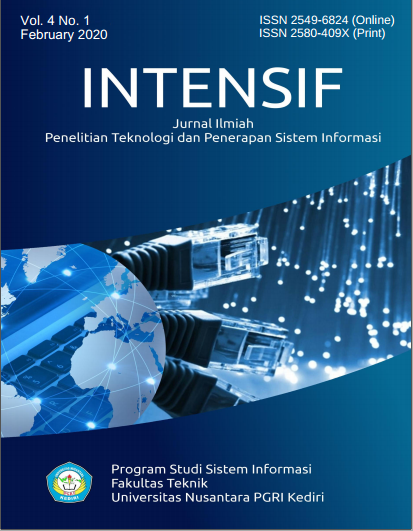Implementation of TF-IDF Algorithm to detect Human Eye Factors Affecting the Health Service System
DOI:
https://doi.org/10.29407/intensif.v4i1.13858Keywords:
Elderly, TF-IDF, Information, SummaryAbstract
Elderly is someone whose age is around 60-74 years, at that age, one's health tends to decrease, and it has an impact on reduced perception, cognition, and psychometry. One result of cognitive decline is a decrease in memory. Programs have been provided by the Indonesian government, such as submitting information, producing brochures, and making announcements on the health services website. But this counseling is not optimal because the elderly tend to be lazy to read this because the eyes have begun to look away from other than that the eye health of the elderly has already started to decrease. So that the health information provided by the health department can be optimized, we try to make a model that is used to summarize an article so that the article is easily understood by the elderly. To summarize the article, this study uses the term frequency-inverse document frequency (TF-IDF) algorithm. By using the TF-IDF algorithm, it is hoped that the elderly will more easily read health articles. User Experience Questionnaire after the application of writing software summary is higher than before the application of writing software summary that is 25.27> 19.30.
Downloads
References
D. Limawan, Y. M. Mewo, and S. H. M. Kaligis, “Gambaran Kadar kalsium serum pada usia 60-74 Tahun,” J. e-Biomedik, vol. 3, no. 1, 2015.
D. Caplan, G. DeDe, G. Waters, J. Michaud, and Y. Tripodis, “Effects of age, speed of processing, and working memory on comprehension of sentences with relative clauses.,” Psychol. Aging, vol. 26, no. 2, p. 439, 2011.
J. Yoon, L. Campanelli, M. Goral, K. Marton, N. Eichorn, and L. K. Obler, “The effect of plausibility on sentence comprehension among older adults and its relation to cognitive functions,” Exp. Aging, Res., vol. 41, no. 3, pp. 272–302, 2015.
S. M. Carmen, “Importance of Counselling for Elderly Before Institutionalization,” Procedia-Social Behav. Sci., vol. 84, pp. 1630–1633, 2013.
D. A. Kurniawati and A. Santoso, “Peningkatan Mutu Pelayanan Kesehatan Usia Lanjut Melalui Peningkatan Kinerja Kader Posyandu Lansia,” in Prosiding Seminar Nasional Unimus, 2018, vol. 1.
O. S. Kwon, J. Kim, K.-H. Choi, Y. Ryu and J.-E. Park, “Trends in deqi research: a text mining and network analysis,” Integr. Med. Res., vol. 7, no. 3, pp. 231–237, Sep. 2018.
M. Sudarma and N. P. Sutramiani, “The Thinning Zhang-Suen Application Method in the Image of Balinese Scripts on the Papyrus,” Int. J. Comput. Appl., vol. 91, no. 1, pp. 9–13, 2014.
S. Sucipto, A. G. Tammam, and R. Indriati, “Hoax Detection at Social Media With Text Mining Clarification System-Based,” JIPI (Jurnal Ilm. Penelitian. Dan Pembelajaran Inform., vol. 3, no. 2, pp. 94–100, 2018.
I. Y. Anggraini, S. Sucipto, and R. Indriati, “Cyberbullying Detection Modelling at Twitter Social Networking,” JUITA J. Inform., vol. 6, no. 2, p. 113, 2018.
T. Lee et al., “Data mining of acupoint characteristics from the classical medical text: Donguibogam of Korean medicine,” Evidence-based Complement. Altern. Med., vol. 2014, Dec. 2014.
Sucipto, Kusrini, and E. L. Taufiq, “Classification method of multi-class on C4.5 algorithm for fish diseases,” in Proceeding - 2016 2nd International Conference on Science in Information Technology, ICSITech 2016: Information Science for Green Society and Environment, 2016, pp. 5–9.
B. Herwijayanti, D. E. Ratnawati, and L. Muflikhah, “Klasifikasi Berita Online Dengan menggunakan Pembobotan TF-IDF dan Cosine Similarity,” J. Pengemb. Teknol. Inf. dan Ilmu Komputer. e-ISSN, vol. 2548, p. 964X, 2018.
S. S. Bhanuse, S. D. Kamble, and S. M. Kakde, “Text mining using metadata for generation of side information,” Procedia Comput. Sci., vol. 78, pp. 807–814, 2016.
H. Gupta, A. Kottwani, S. Gogia, and S. Chaudhari, “Text analysis and information retrieval of text data,” in 2016 International Conference on Wireless Communications, Signal Processing and Networking (WiSPNET), 2016, pp. 788–792.
S. Jabri, A. Dahbi, T. Gadi, and A. Bassir, “Ranking of text documents using TF-IDF weighting and association rules mining,” in 2018 4th International Conference on Optimization and Applications (ICOA), 2018, pp. 1–6.
S. Kalra, L. Li, and H. R. Tizhoosh, “Automatic Classification of Pathology Reports using TF-IDF Features,” arXiv Prepr. arXiv1903.07406, 2019.
W. Dai, “Improvement and Implementation of Feature Weighting Algorithm TF-IDF in Text Classification,” in 2018 International Conference on Network, Communication, Computer Engineering (NCCE 2018), 2018.
B. Das and S. Chakraborty, “An Improved Text Sentiment Classification Model Using TF-IDF and Next Word Negation,” arXiv Prepr. arXiv1806.06407, 2018.
Downloads
Published
Issue
Section
License
Authors who publish with this journal agree to the following terms:
- Copyright on any article is retained by the author(s).
- The author grants the journal, the right of first publication with the work simultaneously licensed under a Creative Commons Attribution License that allows others to share the work with an acknowledgment of the work’s authorship and initial publication in this journal.
- Authors are able to enter into separate, additional contractual arrangements for the non-exclusive distribution of the journal’s published version of the work (e.g., post it to an institutional repository or publish it in a book), with an acknowledgment of its initial publication in this journal.
- Authors are permitted and encouraged to post their work online (e.g., in institutional repositories or on their website) prior to and during the submission process, as it can lead to productive exchanges, as well as earlier and greater citation of published work.
- The article and any associated published material is distributed under the Creative Commons Attribution-ShareAlike 4.0 International License












